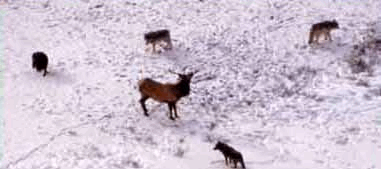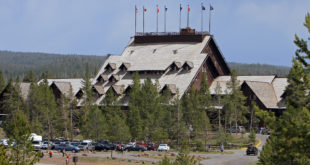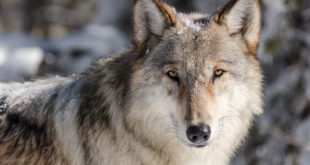Two hundred years ago, around 1800, Yellowstone looked much like it does today; forest covered mountain areas and plateaus, large grassy valleys, and open sagebrush hills. There were numerous herds of elk, antelope, native alpine bison, deer, and mountain sheep. The apex predator (top of the food chain) was the wolf, as it had been for thousands of years. We don’t know exactly how many wolves were in the Yellowstone region at that time, but a good guess is between 300 and 400. They were gray wolves of the sub-species canis lupus irremotus, the Rocky Mountain gray wolf. Weighing in around 70-135 lbs (32-62 Kg), they are among the largest wolves and a successful predator of the bigger ungulates — hoofed grass eaters such as elk and bison.
Also living in this territory were approximately 400-500 Native Americans, mostly of the Tukudika tribe. Perhaps as many as 2,000 people from other tribes crossed the area in summer going to and from hunting territories. Native Americans did not casually hunt or kill wolves, in fact, for most northern tribes the wolf was a sacred animal. They saw much of themselves in the wolf. They revered its hunting prowess, its devotion to the welfare of the pack, and its struggle to survive. Wolves and Native Americans hunted the same elk and bison herds, but the understanding was that each took its share. Usually there was enough to go around.

Killing Varmints
During the late 1800s, as ranches and farms spread into the valleys of the Yellowstone region, the native buffalo were killed and replaced by cattle, sheep, and other domesticated animals. It was inevitable that wolf packs would discover a new food source –- livestock. Predators are obviously unwelcome to those who raise animals, as they make the economics more precarious. A big spring snowstorm might kill hundreds of stock animals, but that’s an act of God that the ranchers can’t do much about. If a pack of wolves appears and begins to take livestock, there is something to do about it -– kill them. Traditionally, settlers moving into America’s frontier immediately began to exterminate local predators — varmints. The general opinion was that anything which made the business of farming or ranching more difficult — prairie dogs, buffalo, wolves, or coyotes — should be eliminated.
Wily the wolf might be, but it’s no match for human hunters with technology: accurate long distance rifles, sophisticated traps, and above all, poison. Coordinated programs of predator extermination began in the early 1900s, which included coyotes as well as wolves. This was not just a practice of local ranchers and farmers, but a professional enterprise of bounty hunting supported by state and federal agencies, notably the federal Bureau of Science. This eradication was effective; by the 1930’s the wolf population in the lower United States was almost entirely wiped out. In 1924, the last known wolves in Yellowstone, two pups discovered near Soda Butte, were officially killed by park rangers. For seventy years there were either no or very few wolves in the greater Yellowstone region. They were eliminated even from the national park and surrounding national forests because it was feared if any remained, they would spread back into the private lands.
Yellowstone without Wolves
As might be expected, after wolves were removed, elk herds increased in population, reaching new highs during the mid-1930’s. The increased number of elk apparently resulted in overgrazing in parts of Yellowstone. Park officials decided that the elk herd should be “managed.” This meant that for about thirty years the park elk herds were culled: Each year some were captured and shipped to other locations, a certain number were killed by park rangers, and hunters were allowed to take more elk that migrated outside the park. By the late 1960’s the herd populations dropped to historic lows (less than 4,000 for the Northern Range herd). This caused outrage among both conservationists and hunters. The park service stopped culling elk in 1968. Then the elk population rebounded and twenty years later there were more elk in Yellowstone than ever (the Northern Range herd reached 19,000); overgrazing returned.
Meanwhile, other things happened: Coyotes survived the extermination programs and without the wolf competition, increased in numbers throughout Yellowstone and became the dominant predator. However, more coyotes meant fewer rodents and other small game, which reduced the population of foxes, hawks, and eagles. In periods where the elk flourished, the aspen trees in the park declined, which contributed to the disappearance of beaver that rely on aspen for a primary food source. Today we catalog these and many other similar effects, mostly in hindsight. What was missing in the 1940’s and 50’s was a sense of what we now call ecology.
Many of the concepts of ecology, such as the relationship of prey and predator (the food chain) or the cycles of growth in plant life (part of biological succession), were developed in the 19th century. However it was not until the mid to late 20th century that an understanding of ecology, ecosystems, and environmentalism gained widespread scientific and public acceptance.In Yellowstone the acceptance of these ideas prompted a slowly developing re-evaluation of how to manage the park’s plant and animal life. Partly because of the poor track record for hands-on management (like culling) and partly because study of Yellowstone as an ecosystem was beginning to reveal just how complex and variable the system could be; more and more ideas were floated about ‘restoring the natural balance.’ That meant, as much as possible, supporting natural regulation; letting natural forces take their course. Among the ideas on how to do this was the reintroduction of the wolf to control the elk population.
Controversial Comeback
 For a variety of reasons wolf packs break up and individuals, pairs, or sub-packs disperse. After wolves were largely extirpated from the United States (excluding Alaska), wolves from Canada dispersed into areas near the border. A few packs were seen in Northern Minnesota and then Northwest Montana. Eventually individual (non-breeding) wolves dispersed southward into Montana and by about the mid-1980s reached the Greater Yellowstone Region.While this was occurring, the United States passed the Endangered Species Act of 1973, which provided laws and regulations concerning the protection and encouragement of plants and animals threatened with extinction. The gray wolf was one of the animals immediately listed as endangered.
For a variety of reasons wolf packs break up and individuals, pairs, or sub-packs disperse. After wolves were largely extirpated from the United States (excluding Alaska), wolves from Canada dispersed into areas near the border. A few packs were seen in Northern Minnesota and then Northwest Montana. Eventually individual (non-breeding) wolves dispersed southward into Montana and by about the mid-1980s reached the Greater Yellowstone Region.While this was occurring, the United States passed the Endangered Species Act of 1973, which provided laws and regulations concerning the protection and encouragement of plants and animals threatened with extinction. The gray wolf was one of the animals immediately listed as endangered.
The Endangered Species Act also included provisions for protection of the environment in which the endangered species lived.The Endangered Species Act made it a federal mandate for the United States Fish and Wildlife Service (FWS) to do what it could to repopulate the gray wolf, which in practical terms meant reintroduction. Exploration of this possibility began as early as 1975 with the formation of the Rocky Mountain Wolf Recovery Team. The beginnings were relatively quiet, but the release of the first report in 1980 launched what has become known as the Wolf Wars.
Almost everything in Yellowstone National Park is under the magnifying glass not only of rangers and scientists, but also hunters, farmers, ranchers, corporate interests, tourists, conservationists, and politicians. Very little occurs in Yellowstone that does not provoke a reaction. This is particularly true of animals. Even the hint of reintroducing wolves to Yellowstone (the first report made no recommendations) was enough to polarize the situation.
Through the next fifteen years (1980-1995), the battle over wolves in Yellowstone (also for Idaho and Montana) involved hundreds of debates, town meetings, editorial commentary, media coverage, legal maneuvering, political posturing, back-room dealing, and an act or two of Congress. The vibes, good and bad, which propagated from the controversy, are still reverberating.
The controversy had many facets: Farmers and ranchers quite realistically knew that wolves would kill livestock and could threaten their livelihood. Hunters feared that wolves would reduce the availability of game animals. Lots of people just feared wolves, period. Beyond the wolves themselves, the controversy quickly involved age-old animosities between agencies of the federal government and many individuals and organizations in the West. Political battles about states’ rights, government interference in the lives of people, and the validity of scientific knowledge were drawn into the mix.
Waging a Battle Over Wolves
In the most polarized position, those who opposed wolves wanted no re-introductions anywhere in Idaho, Montana, or Wyoming (including Yellowstone); the wolves should be delisted as an endangered species (so they could be hunted at-will as predators); and those wolves already in the region should be left as is (except to be hunted).
Those who favored wolves preferred managed re-introductions throughout the Northern Rocky Mountains with wolves carrying the full endangered species protection. This point of view was riding the wave of environmental concern in the United States, and the growing awareness of vanishing wilderness and wildlife. If nothing else, the Wolf Wars helped galvanize public awareness of the issues—a national constituency (and votes) for the wolves developed, which eventually more than counterbalanced the politically organized but smaller local opposition.
Throughout the entire fifteen years there was a see-saw battle that was often very bitter and sometimes radical (on both sides). Environmental Impact Studies were conducted. There were court cases. National politics, such as who was President or in charge of Congress, affected the process. In the end, it came down to a very American solution: compromise.
Many of those who opposed wolf reintroduction became aware that it would only be a matter of time before native wolf packs developed throughout the Rocky Mountains. If these wolves were fully covered by the Endangered Species Act, it would be illegal to kill them for any reason. Worse, under the Endangered Species Act it would be possible to ban ranching, mining, logging, and hunting from areas where wolves were repopulating. Since environmental concerns were in the ascendency in the United States, and the Endangered Species Act itself was going to remain largely untouchable; compromise came to look like a better approach.
In order to get enough support for re-introducing wolves into Yellowstone and Central Idaho, four compromises were important: The first was that wolves outside Yellowstone Park would fall under a special amendment to the Endangered Species Act (“experimental non-essential population”) and could be killed on grounds of livestock predation. The second was a policy that the presence of wolves would not curtail multiple use (hunting, logging, etc.) in the area outside the park. The third compromise was inclusion in the re-introduction plan that when the wolf packs at each location reached 100 individuals and 10 packs, wolves would be de-listed as endangered and their management would pass from the federal to state governments. Finally, the fourth piece of compromise consisted of the formation in 1989 of a private organization, the Trust Fund for Wolf Restoration, which agreed to pay ranchers and farmers at market value for livestock proven to have been killed by wolves.
As is expected with compromise, not everybody was happy. Many environmentalists objected to the open-ended ‘wolves are fair game’ aspect; ranchers and others found problems with the terms of compensation for predation and other restrictions. However, on March 21, 1995 the first batch of 14 wolves were released from holding pens near the Buffalo Ranch in Lamar Valley. Wolf packs returned to Yellowstone.
In 1995, 14 wolves were transported from the Canadian Rockies in Alberta and held ten weeks to acclimate to Yellowstone in three ‘wolf pens’ located in the Lamar Valley. They were the first to be released.
In 1996, 17 additional wolves from British Columbia, Canada were released from pens in the Blacktail Plateau and Firehole River valley.
Post-Reintroduction
With a record number of elk in Yellowstone’s Northern Range the table was set for the re-introduction of wolves, but that did not guarantee success. The wolves that were released in the first year needed to do three things to survive: Form packs, find and kill enough animals for food, and raise puppies. In unfamiliar territory, with wolves unfamiliar to each other, this was by no means a done deal.
More or less out of the chute, three packs were formed and given names of the area they first inhabited: Rose Creek, Crystal Bench, and Soda Butte. The packs quickly adapted to hunting elk, mostly calves, and small game. In the first year, most of the packs left the Lamar area, presumably exploring, and later returned. The Rose Creek pack took off to the northeast and soon arrived at the edge of the wilderness near Red Lodge, Montana. Here the alpha male was shot by a man who was arrested and given a six month prison term. The alpha female of the pack and her eight pups were relocated back to the Lamar pens and later re-released. The second release in 1996 formed four more packs, among them the renowned Druid Peak pack and the Leopold pack. From the packs of that year came fourteen surviving pups. It was decided that because of this success (and reduced funding) that transporting more wolves was not necessary. The Yellowstone wolf population was on its own way.
Northern Rocky Mountain Wolf Population 2006
| Yellowstone National Park | 136 in 13 packs |
| Wyoming (including Yellowstone) | 311 |
| Montana | 316 |
| Idaho | 673 |
| TOTAL | Approximately 1,300 |
After Ten Years
In 2005, after ten years of wolves in Yellowstone, the wolf reintroduction program was given a full re-examination of the original Environmental Impact Statement. As these things go, the predictions made in May of 1994 (the time of original EIS) were remarkably (surprisingly?) accurate. Here are a few key points, but reading the full account (see reference below) provides many other significant points:
| EIS Prediction | Ten Year Evaluation |
| Following wolf recovery (10 packs, 100 wolves), hunter harvest will be reduced 27% for antlerless elk, 100% for mule deer, and 50% for moose. | Contrary to expectations, harvests were not reduced appreciably concurrent with wolf restoration, but instead remained similar to pre-wolf restoration years. However, Montana Fish, Wildlife and Parks gradually reduced antler-less permits for the Gardiner late elk hunt by 51% from 2,882 to 1,400 during 2000–2004. They recently proposed 100 permits for 2006, a 96% decrease from the 2,660 permits issued in 1995, owing to decreasing abundance and low recruitment. No reductions in permits, animals harvested, or hunter success for mule deer or moose have occurred as a result of wolf reintroduction. |
| Losses of livestock from wolf predation will not average more than 0.1% of any class of livestock in the analysis area and no cumulative impact on livestock populations is expected. | Livestock losses to wolves did not exceed 0.1% per year for any class of livestock. |
| Land management agencies may restrict public access around active wolf den sites from April 1 to June 30 when there are five or fewer breeding pairs. About 5 mi2 (13 km2 could be affected. No land use restrictions will be employed after six breeding pairs of wolves are established. | Land use restrictions occurred around active wolf dens inside national parks. The area of use affected was approximately 2 mi2 (4 km2). These restrictions have continued after six breeding pairs of wolves were established. |
| Wolf management costs associated with reintroduction in the GYE were estimated to include $3,077,500 for a five year reintroduction effort (1994–1998) and about $1.3 million for monitoring and wolf control (1999–2002), or about $320,000 per year. Reintroduction in central Idaho (1994–1998) was expected to cost about another $2 million | Wolf reintroduction proved to be less costly and speedier than anticipated. Actual wolf reintroduction took only two years, not five, and cost only about $870,000 for both Yellowstone and Idaho combined ($585,000 in the first year and $285,000 in the second year). However, the combined annual continuing costs of wolf monitoring and management are now substantially higher than earlier estimates, even when corrected for inflation. For example, the U.S. Fish and Wildlife Service estimates the additional continuing cost to taxpayers until delisting will be about $1.5 million per year. |
Conclusions
From the point of view of biologists and park management, the Wolf Recovery Project is considered a major success, in fact, one of the most successful wildlife projects in U.S. history. For tourists and fans of Yellowstone, the addition of wolves to the park’s attractions continues to be enormously popular. This does not mean the reintroduction of wolves to the Greater Yellowstone Region is over. Wolves continue to disperse and assemble packs throughout the region. The reintroduction and its effects continue as a major subject for study and analysis. Not unexpectedly it also continues as a source of controversy. (For more on these topics, see the section in Yellowstone Insider on Yellowstone Wolves: Current Topics.)
Nelson King, Senior Editor, 2007 Updated: 6/20/2009
MORE ON WOLVES….
Wolves in Yellowstone: About Wolves
Wolf Attacks on People
When and Where to See Wolves
Greater Yellowstone Ecosystem Wolf Pack Map 2008
Issues: How Many Wolves are Enough?
 Yellowstone Insider Your Complete Guide to America's First National Park
Yellowstone Insider Your Complete Guide to America's First National Park






